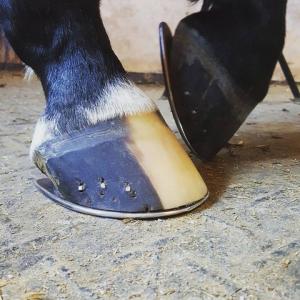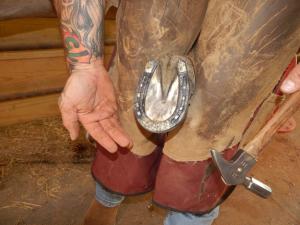By Tara N. Moody
If you had told me years ago that I would marry a man who shoes horses, I’d have said ‘you are crazy.’ But on December 24, 2015, I married my true love, Micah Moody – a farrier.
I remember the first time he took me along on a job when we first began dating in 2013. I had never met a farrier before and I actually hadn’t been around horses very much growing up. As I watched him from a “safe” distance, I became captivated. While he had a full time job elsewhere, farrier work was his true calling, his passion, his gift – and additional source of income. I fondly nicknamed Micah “the Horse Whisperer,” from my observations of the way he approached the horse with ease, the way he picked up the hoof and reached for his tools. This could be awkward for many people, but he does the job with a smile and exudes sheer joy as he works. As an artist myself, I see farrier work as an art form.
That first day of observing my boyfriend shoeing a horse changed my life. I soon realized that I wanted to be around horses all the time. Already an animal lover, I found handling these large, beautiful creatures quite satisfying. Micah taught me how to hold them properly as he works. He taught me safety rules and how to be ready for anything, since horses can be unpredictable and have different personalities. Much like people!
Micah and I soon realized that, although we had other options, farrier work is the life’s work we wanted to do together. Micah comes by his affinity for farrier work honestly. His grandfather and great grandfathers were both farriers. And he already had nearly 15 years of experience under horses. So we decided to quit our other jobs and commit to farrier work full time; thus, Micah Moody Horseshoeing was born. Micah had apprenticed under a family friend, Rick Baggett of Pontotoc, Mississippi, and continued to work with him as we began to market this new business. It didn’t take long before Micah’s clientele numbered almost 150 horses.
Micah is a traveling farrier and I ride alongside him, handling his scheduling, handling horses, and whatever else he may need. I have learned a lot over these past two years, especially that farrier work is not just a career; it’s a lifestyle that may not be for everyone.
The days of a farrier begin early and end late. Most weekends are not our own, as we are available for clients who may need his services. A typical day for Micah begins with a hot shower for Micah to loosen tired his muscles, lots of coffee, a monster biscuit from Hardees, and our music. I throw on some old clothes (the horses don’t care about fashion), put my hair in a bun, and jump in the truck with Micah. I have the schedule book in hand so I can navigate the stops. Most days we have about three different places to go, and our hope is that the horses will be caught and patiently awaiting our arrival. However, there are times when we have to grab buckets of feed and catch the horses ourselves. We have to always be prepared for anything!
Micah, as most farriers do, offers trimming and shoeing. There may be three trims and one to shoe at the first stop, which can be as far away as 100 miles from our home; but the travel mileage varies daily. We started out hauling the equipment in the back of a pickup truck, but now have “graduated” to a topper rig that opens from three sides.
Once we arrive at the barn, Micah unloads his tools, forge, and anvil. Set up is quick because Micah keeps his tools organized for efficiency. I often tease him about the way he “babies” his farrier tools, on which he spends hours at home cleaning and organizing.
Trimming the hoof is the first part of the hoof care and shoeing process. He nips and rasps the hoof first; then he finds the proper shoe to fit the horse for the job the horse does. Whether it’s a barrel racing horse, a hunter/jumper, or other type of show horse, we have to have a variety of shoes to fit a variety of horses. If a horse mainly stays in a pasture and doesn’t get ridden much, barefoot trims are a great option.
He fires up the forge and begins to shape the shoe to custom fit the hoof. After heating the shoe, he hammers it on the anvil to shape the shoe. Once the shoe is ready, he’s back under the horse with six nails sticking out of his mouth, which he will soon hammer into the shoe, attaching it to the horse’s hoof. People have asked us if this hurts the horse, but the answer is plainly “no” (unless the nail unintentionally goes into the sensitive part of the hoof).
It may be painless for the horse, but not so for the farrier. The farrier is bent over, holding a hoof (a fourth of a 1200-pound horse) in his hands, in an awkward position for hours at a time. This is very hard on the back, so a farrier’s muscles must be well developed since his strength and health are crucial to his career.
Some may argue that a horse’s hooves don’t need trimming or shoeing, but this is not correct. I have observed horses whose hooves weren’t trimmed on a regular basis and they developed problems because of this – usually some type of lameness. Folks know the saying: “no foot, no horse.” We horse owners are responsible for taking care of our horses, and some consider it a privilege.
We try to keep our clients on a 6-8 week maintenance schedule after the first shoeing or trimming. This schedule is crucial to hoof health. There are still a lot of issues and conditions that can arise and require extra attention, such as thrush, founder, or navicular disease.
I never knew how important a farrier’s job is until I met Micah. Now I am “horse crazy” and wouldn’t want to spend another day without these amazing animals. Working together in our business we have developed special bonds with each other, with the horses we serve, and with the horse owners. Micah truly loves what he does and the horses always come first. I hope this article sheds some light on the life of a farrier and helps people to appreciate them and how hard they work to keep your horses sound. As Micah has grown in his education and knowledge, so has his operation. Professionalism is vital to anyone running their own business, and a farrier’s work is no exception.
If you had told me years ago that I would marry a man who shoes horses, I’d have said ‘you are crazy.’ But on December 24, 2015, I married my true love, Micah Moody – a farrier.
I remember the first time he took me along on a job when we first began dating in 2013. I had never met a farrier before and I actually hadn’t been around horses very much growing up. As I watched him from a “safe” distance, I became captivated. While he had a full time job elsewhere, farrier work was his true calling, his passion, his gift – and additional source of income. I fondly nicknamed Micah “the Horse Whisperer,” from my observations of the way he approached the horse with ease, the way he picked up the hoof and reached for his tools. This could be awkward for many people, but he does the job with a smile and exudes sheer joy as he works. As an artist myself, I see farrier work as an art form.
That first day of observing my boyfriend shoeing a horse changed my life. I soon realized that I wanted to be around horses all the time. Already an animal lover, I found handling these large, beautiful creatures quite satisfying. Micah taught me how to hold them properly as he works. He taught me safety rules and how to be ready for anything, since horses can be unpredictable and have different personalities. Much like people!
Micah and I soon realized that, although we had other options, farrier work is the life’s work we wanted to do together. Micah comes by his affinity for farrier work honestly. His grandfather and great grandfathers were both farriers. And he already had nearly 15 years of experience under horses. So we decided to quit our other jobs and commit to farrier work full time; thus, Micah Moody Horseshoeing was born. Micah had apprenticed under a family friend, Rick Baggett of Pontotoc, Mississippi, and continued to work with him as we began to market this new business. It didn’t take long before Micah’s clientele numbered almost 150 horses.
Micah is a traveling farrier and I ride alongside him, handling his scheduling, handling horses, and whatever else he may need. I have learned a lot over these past two years, especially that farrier work is not just a career; it’s a lifestyle that may not be for everyone.
The days of a farrier begin early and end late. Most weekends are not our own, as we are available for clients who may need his services. A typical day for Micah begins with a hot shower for Micah to loosen tired his muscles, lots of coffee, a monster biscuit from Hardees, and our music. I throw on some old clothes (the horses don’t care about fashion), put my hair in a bun, and jump in the truck with Micah. I have the schedule book in hand so I can navigate the stops. Most days we have about three different places to go, and our hope is that the horses will be caught and patiently awaiting our arrival. However, there are times when we have to grab buckets of feed and catch the horses ourselves. We have to always be prepared for anything!
Micah, as most farriers do, offers trimming and shoeing. There may be three trims and one to shoe at the first stop, which can be as far away as 100 miles from our home; but the travel mileage varies daily. We started out hauling the equipment in the back of a pickup truck, but now have “graduated” to a topper rig that opens from three sides.
Once we arrive at the barn, Micah unloads his tools, forge, and anvil. Set up is quick because Micah keeps his tools organized for efficiency. I often tease him about the way he “babies” his farrier tools, on which he spends hours at home cleaning and organizing.
Trimming the hoof is the first part of the hoof care and shoeing process. He nips and rasps the hoof first; then he finds the proper shoe to fit the horse for the job the horse does. Whether it’s a barrel racing horse, a hunter/jumper, or other type of show horse, we have to have a variety of shoes to fit a variety of horses. If a horse mainly stays in a pasture and doesn’t get ridden much, barefoot trims are a great option.
He fires up the forge and begins to shape the shoe to custom fit the hoof. After heating the shoe, he hammers it on the anvil to shape the shoe. Once the shoe is ready, he’s back under the horse with six nails sticking out of his mouth, which he will soon hammer into the shoe, attaching it to the horse’s hoof. People have asked us if this hurts the horse, but the answer is plainly “no” (unless the nail unintentionally goes into the sensitive part of the hoof).
It may be painless for the horse, but not so for the farrier. The farrier is bent over, holding a hoof (a fourth of a 1200-pound horse) in his hands, in an awkward position for hours at a time. This is very hard on the back, so a farrier’s muscles must be well developed since his strength and health are crucial to his career.
Some may argue that a horse’s hooves don’t need trimming or shoeing, but this is not correct. I have observed horses whose hooves weren’t trimmed on a regular basis and they developed problems because of this – usually some type of lameness. Folks know the saying: “no foot, no horse.” We horse owners are responsible for taking care of our horses, and some consider it a privilege.
We try to keep our clients on a 6-8 week maintenance schedule after the first shoeing or trimming. This schedule is crucial to hoof health. There are still a lot of issues and conditions that can arise and require extra attention, such as thrush, founder, or navicular disease.
I never knew how important a farrier’s job is until I met Micah. Now I am “horse crazy” and wouldn’t want to spend another day without these amazing animals. Working together in our business we have developed special bonds with each other, with the horses we serve, and with the horse owners. Micah truly loves what he does and the horses always come first. I hope this article sheds some light on the life of a farrier and helps people to appreciate them and how hard they work to keep your horses sound. As Micah has grown in his education and knowledge, so has his operation. Professionalism is vital to anyone running their own business, and a farrier’s work is no exception.













